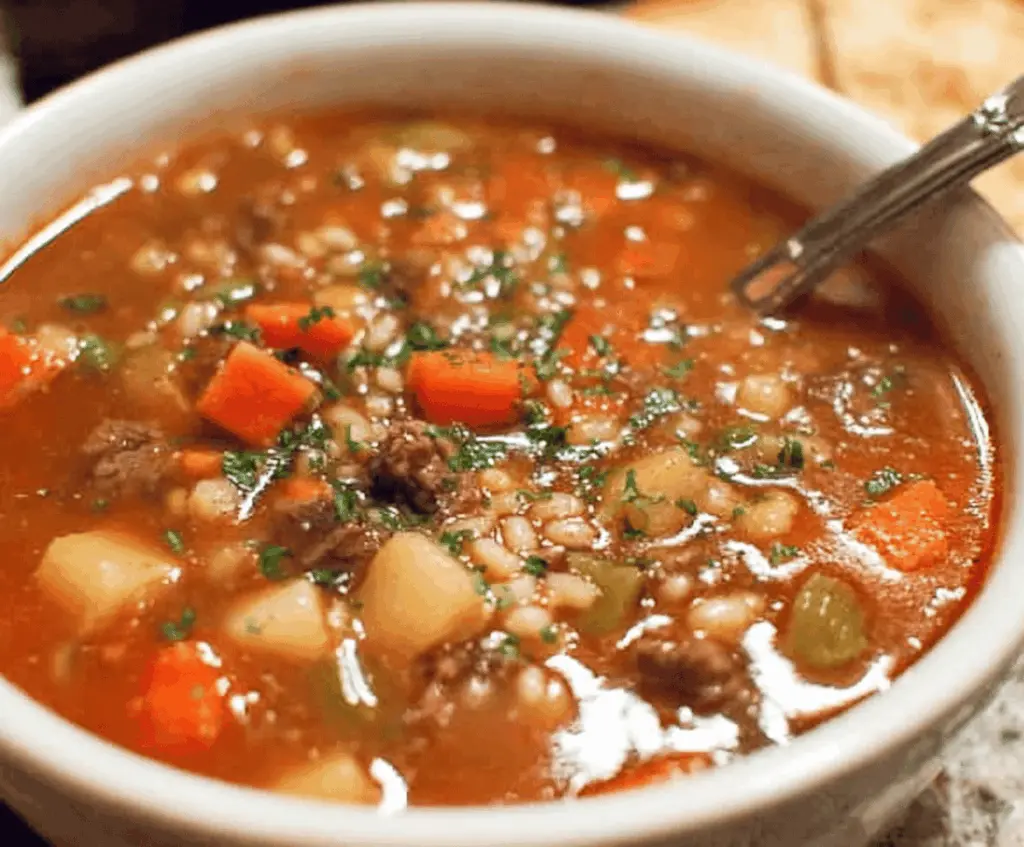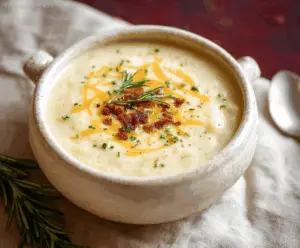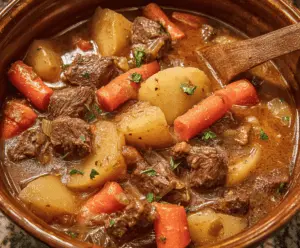Vegetable Beef Soup is a hearty and comforting bowl filled with tender chunks of beef, fresh vegetables like carrots, celery, and potatoes, all simmered together in a rich, flavorful broth. It’s the kind of soup that feels like a warm hug on a chilly day, with a balance of meaty goodness and garden-fresh veggies.
I love making this soup when I want something simple but satisfying, especially because it’s great for using up whatever veggies I have on hand. One tip I’ve learned is to let it simmer slowly so the beef gets super tender and the flavors have time to meld. I find that it tastes even better the next day, which means it’s perfect for leftovers or meal prep.
My favorite way to enjoy Vegetable Beef Soup is with a slice of crusty bread for dipping—especially on those lazy weekend afternoons. It’s a go-to for family dinners because everyone can find something they like in it, and it warms up the whole kitchen with its cozy aroma. This soup always reminds me of home and good times shared around the table.
Key Ingredients & Substitutions
Beef: Using lean ground beef keeps the soup lighter, but stew meat adds extra tenderness and flavor with slow cooking. If you want to skip the beef, try mushrooms or lentils for a veggie-friendly version.
Vegetables: Carrots, celery, onions, and potatoes are classic soup veggies. Feel free to swap in whatever you have—zucchini, green beans, or frozen peas work well too.
Pearl Barley or Pasta: Barley gives a nice chewy texture and heartiness. If you don’t have it, small pasta shapes like ditalini or orzo make good substitutes. Keep in mind pasta cooks faster, so add it later.
Herbs: Thyme, parsley, and bay leaf boost the soup’s flavor subtly. Fresh herbs at the end add brightness, but dried herbs work well during cooking and are convenient.
How Do You Make Sure the Beef Is Tender and Flavorful?
Getting tender beef in soup is key for a great experience. Here’s how I do it:
- Use stew meat or chunk the beef into bite-sized pieces if not ground.
- Brown the beef first to create rich flavor through caramelization.
- Cook the soup at a low simmer for 45 minutes to an hour—slow and steady helps break down tough fibers.
- If using ground beef, just cook it until browned and don’t overcook once in the soup to keep it from drying out.
- Adding a bit of acid like canned tomatoes or a splash of vinegar near the end brightens flavors and helps tenderize.
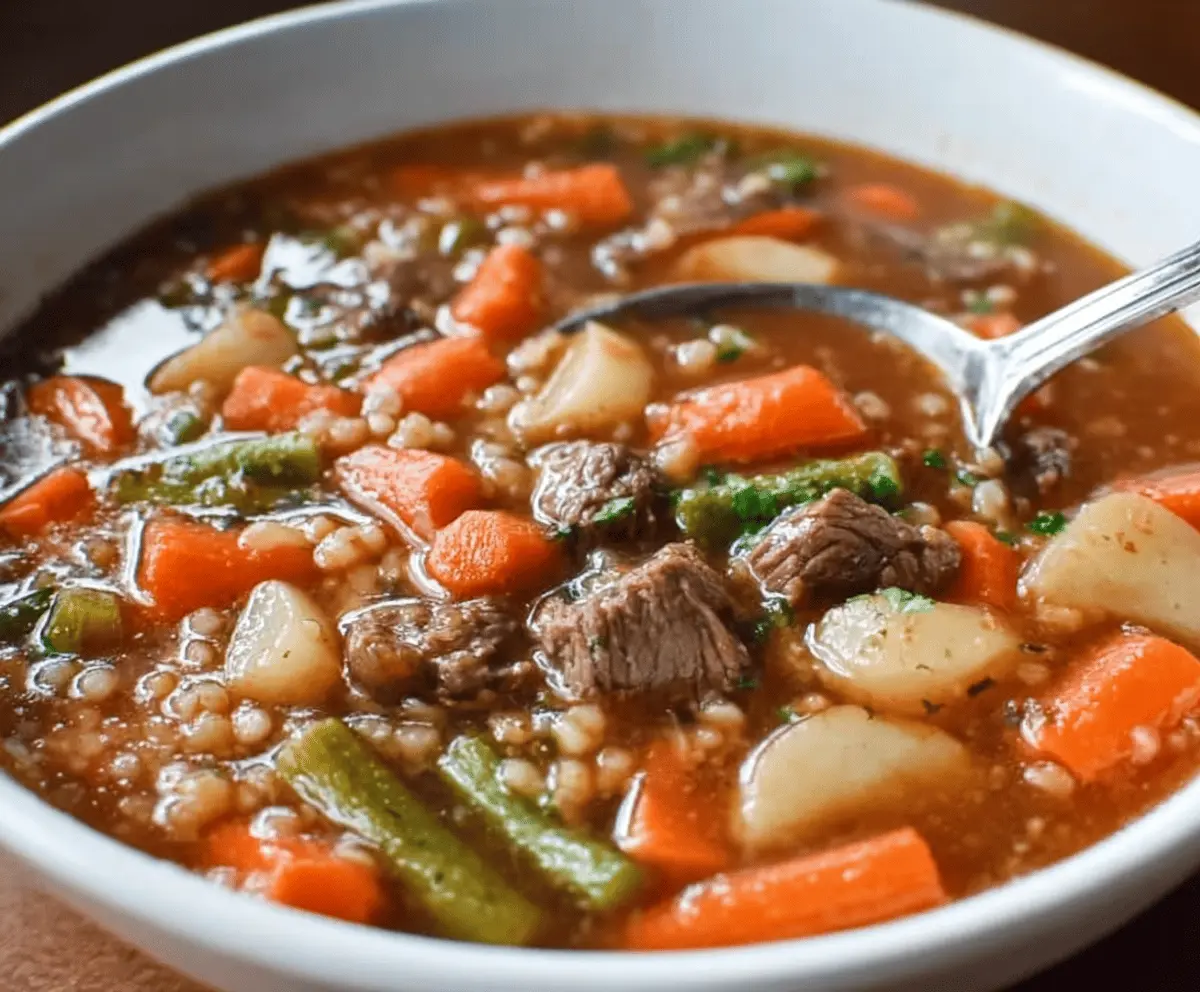
Equipment You’ll Need
- Large soup pot – I prefer a big pot to fit all the ingredients comfortably and make stirring easier.
- Sharp knife and cutting board – for chopping vegetables and cutting the beef cubes or ground beef.
- Measuring spoons and cups – to add the right amount of herbs, liquids, and seasonings.
- Wooden spoon or ladle – best for stirring the soup and serving it hot.
- Soup ladle – to easily serve portions into bowls.
Flavor Variations & Add-Ins
- Use shredded cooked chicken or turkey instead of beef for a different protein twist.
- Add diced green beans or frozen peas in the last 10 minutes for extra color and freshness.
- Mix in a splash of Worcestershire sauce or soy sauce for a savory boost.
- Replace pearl barley with rice or pasta like orzo for a quicker, different texture.
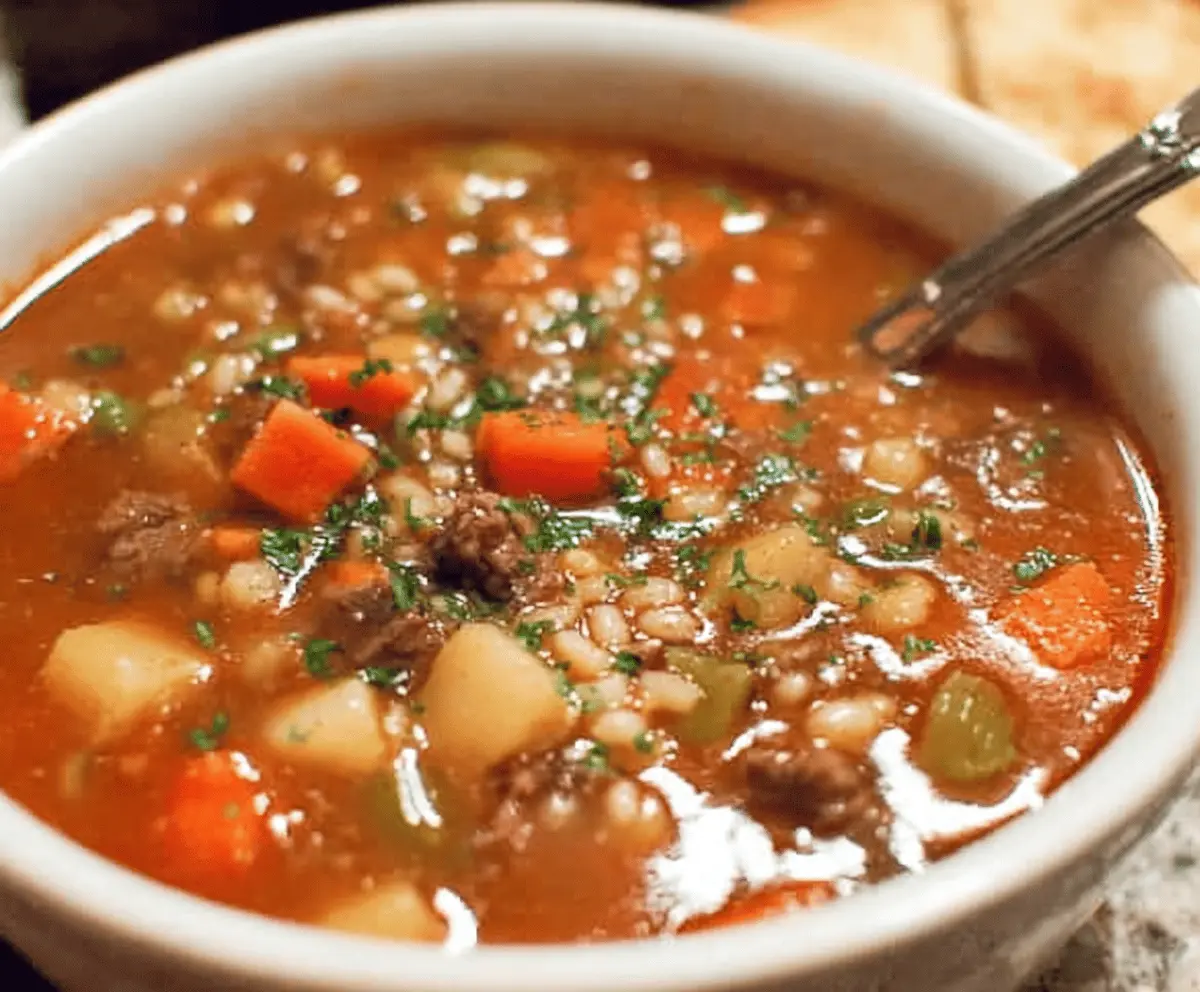
How to Make Vegetable Beef Soup
Ingredients You’ll Need:
For the Soup:
- 1 lb (450g) lean ground beef or beef stew meat, cut into small chunks
- 1 tablespoon olive oil
- 1 medium onion, diced
- 2 cloves garlic, minced
- 3 medium carrots, peeled and diced
- 2 stalks celery, diced
- 2 medium potatoes, peeled and diced
- ½ cup pearl barley or small pasta (optional)
- 4 cups beef broth or stock
- 2 cups water (adjust as needed)
- 1 (14 oz) can diced tomatoes (optional)
- 1 teaspoon dried thyme
- 1 teaspoon dried parsley or 2 tablespoons fresh, chopped
- 1 bay leaf
- Salt and black pepper to taste
- Fresh parsley, chopped for garnish
How Much Time Will You Need?
This recipe takes about 15 minutes to prepare and brown the beef and vegetables, followed by 45 minutes to 1 hour of simmering to let the flavors blend and the beef become tender. Total time is roughly 1 hour to 1 hour 15 minutes.
Step-by-Step Instructions:
1. Brown the Beef:
Heat the olive oil in a large soup pot over medium-high heat. Add the ground beef or beef chunks and cook until browned. If using ground beef, break it up with a spoon as it cooks. Once browned, remove the beef with a slotted spoon and set aside.
2. Cook the Vegetables:
In the same pot, add the diced onion, carrots, and celery. Cook for 5 to 7 minutes until the vegetables begin to soften. Add the minced garlic and cook for another minute until fragrant.
3. Combine Ingredients and Simmer:
Return the browned beef to the pot. Add the diced potatoes, pearl barley or pasta if using, beef broth, water, and diced tomatoes if you like. Stir in dried thyme, parsley, and bay leaf. Season with salt and pepper.
Bring the soup to a boil, then reduce the heat to low. Cover the pot and let it simmer gently for 45 minutes to 1 hour, or until the vegetables and beef are tender, and the barley or pasta is cooked through.
4. Finish and Serve:
Remove the bay leaf. Taste the soup and add more salt and pepper if needed. Ladle the soup into bowls and garnish with fresh chopped parsley. Enjoy it warm with crusty bread or rolls!
Can I Use Frozen Beef for This Soup?
Yes, you can use frozen beef stew meat, but make sure to thaw it completely in the refrigerator overnight before cooking. This helps it brown evenly and prevents excess water from diluting the soup.
Can I Make This Soup Ahead of Time?
Absolutely! In fact, the flavors develop even more after a day. Store the soup in an airtight container in the fridge for up to 3 days, and reheat gently on the stove or in the microwave.
How Do I Store Leftovers?
Keep leftovers in a sealed container in the fridge for up to 3 days, or freeze for up to 2 months. When reheating frozen soup, thaw overnight in the fridge for best results before warming.
Can I Substitute Other Grains or Pasta?
Yes! Pearl barley can be swapped with rice, quinoa, or small pasta shapes like orzo. Just adjust cooking times accordingly, adding pasta later to avoid overcooking.
